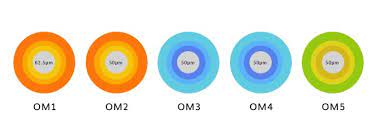The difference between multimode fiber OM3, OM4 and OM5
Since OM1 and OM2 fibers cannot support data transmission speeds of 25Gbps and 40Gbps, OM3 and OM4 are the main choices for multimode fibers that support 25G, 40G, and 100G Ethernet. However, as bandwidth demands increase, so does the cost of fiber optic cables to support the next-generation Ethernet speed migration. In this context, OM5 fiber was born to expand the advantages of multimode fiber in data centers.
OM3 is an 850nm laser-optimized 50um core diameter multimode fiber. In 10Gb/s Ethernet using 850nm VCSEL, the fiber transmission distance can reach 300m; OM4 is an upgraded version of OM3. OM4 multimode fiber optimizes OM3 multimode fiber in The differential mode delay (DMD) generated during high-speed transmission, so the transmission distance is greatly improved, and the optical fiber transmission distance can reach 550m.
The key difference between them is that at 4700MHz-km, the EMB of OM4 fiber is only specified at 850 nm, while the OM5 EMB values are specified at 850 nm and 953 nm, with a larger value at 850 nm than OM4. Therefore, OM5 fiber provides users with longer distances and more fiber options. Additionally, TIA has designated lime green as the official cable jacket color for OM5, while OM4 is the overwater jacket. OM4 is designed for 10Gb/s, 40Gb/s and 100Gb/s transmission, but OM5 is designed for 40Gb/s and 100Gb/s transmission, which reduces the number of fibers for high-speed transmission.
The OM5 can support four SWDM channels, each carrying 25G data, providing 100G Ethernet using a pair of multimode fibers. Additionally, it is fully compatible with OM3 and OM4 fibers. The OM5 can be used worldwide for installations in a variety of enterprise environments, from campuses to buildings to data centers. In conclusion, OM5 fiber is better than OM4 in terms of transmission distance, speed and cost.
Post time: Jun-30-2022
